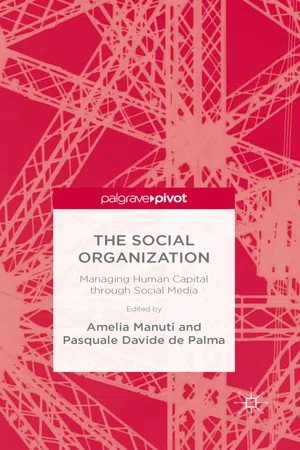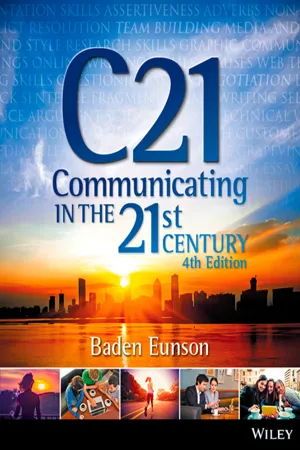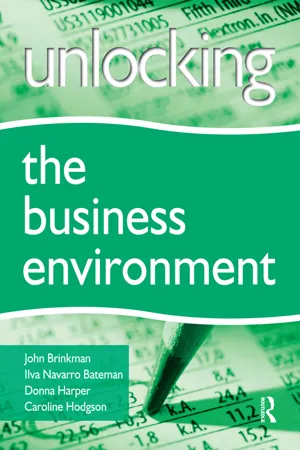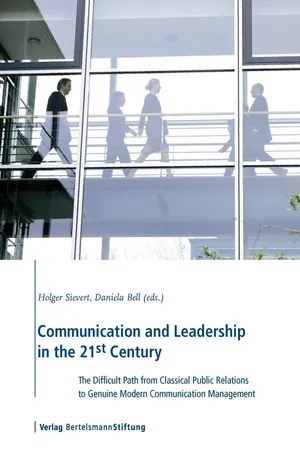Business
Organizational Communication
Organizational communication refers to the exchange of information, ideas, and messages within a business or other type of organization. It encompasses both formal channels, such as official memos and meetings, and informal interactions among employees. Effective organizational communication is crucial for promoting collaboration, sharing goals, and maintaining a positive work environment.
Written by Perlego with AI-assistance
Related key terms
10 Key excerpts on "Organizational Communication"
- eBook - ePub
Communication in Organizational Environments
Functions, Determinants and Areas of Influence
- Anna Rogala, Sylwester Bialowas(Authors)
- 2016(Publication Date)
- Palgrave Macmillan(Publisher)
Organizational Communication.These areas impact all aspects of the organizational life (Miller 1996 ), overlapping and mutually complementing each other. It should be emphasized that it is difficult to demarcate them both from the scientific and practical point of view. Thus, business communication is defined as “the scholarly study of the use, adaptation, and creation of languages, symbols, and signs to conduct activities that satisfy human needs and wants by providing goods and services for private profit” (Reinsch 1996 , p. 28). The goal of management communication is to develop and disseminate knowledge, which is to contribute to increasing the effectiveness and efficiency of modern managers (Smeltzer 1996 , pp. 22–23). Importantly, this approach highlights the role of management in the Organizational Communication process, the obligations connected with it, as well as the importance of communicative competence as such. Next, corporate communication is defined as “a corporation’s voice and the images it projects of itself on a world stage populated by its various audiences, or what we refer to as constituencies” (Argenti and Forman 2002 , p. 4). This concept is thus wider than the previous two as it includes both internal and external communication. Defining Organizational Communication, D. Tourish and O. Hargie note that it consists of how the members of an organization attribute meanings to messages within verbal and non-verbal communication, communication skills, and communicative effectiveness, and how they distort these meanings when communicating with one another through both formal and informal channels (2004 , p. 10). In an attempt to conduct a comprehensive analysis of Organizational Communication, H. Kalla proposes adopting a holistic approach. Its principal construct is integrated internal communication, which should be understood as all formal and informal communication taking place internally at all levels in an organization (2005 , p. 304). Naturally, the proponents of this concept also recognize the relationships and dependencies between external and internal communication (Cheney and Christensen 2001 ; Kalla 2005 - eBook - ePub
Human Communication Theory and Research
Concepts, Contexts, and Challenges
- Robert L. Heath, Jennings Bryant(Authors)
- 2013(Publication Date)
- Routledge(Publisher)
Members of organizations attempt to make rational decisions about their performance; they seek to maximize the rewards for their efforts while minimizing the costs. Members of organizations communicate to perform tasks and enact roles on behalf of those organizations. Individuals negotiate with other organizational members, including management on how those tasks and roles will be performed.The study of Organizational Communication centers on means by which people gain information, shape opinions, make decisions, coordinate efforts, voice expectations, assimilate into the organization, leave the organization, and create rapport with one another. Through communication, people coordinate their actions to achieve individual and collective goals. This process begins early in people’s lives and continues as they mature. People learn communication styles and content at an early age from other family members, educational institutions, media, and work experience.The study of Organizational Communication focuses on processes of interaction, means by which members create shared meaning, and strategic coordination of goal-oriented activities. Organizational Communication is not something that transpires within a “box” (the organization) but rather what happens between people who are members of an organization or outsiders who interact with them. Rather than thinking of an organization communicating, it is best to think of people communicating within and on behalf of an organization. This action is not random, but coordinated; it requires that members acquire and share information as well as persuade one another on an array of matters. Actions and statements of individuals bring the organization to life. Meaning (individual and shared opinions) influences what people do and how they do it. Actions are affected by the “culture” and “climate” of each organization.This chapter examines variables and theories to explain why people communicate as they do as a consequence of their membership in organizations. Themes address the unique nature of Organizational Communication, organizations as systems and as shared meaning. The chapter focuses on units of analysis: interpersonal, especially superior–subordinate interactions, task-group interaction, and the organization communicating inwardly and externally to foster mutually beneficial relationships with key stakeholders. - eBook - ePub
The Social Organization
Managing Human Capital through Social Media
- Amelia Manuti, Pasquale Davide de Palma(Authors)
- 2016(Publication Date)
- Palgrave Macmillan(Publisher)
Accordingly, Organizational Communication has laid the framework for scholars to determine how communication affects all aspects of functioning within an organization. Communication will always be an essential part of an organization because it connects each individual function and group as a whole, and it is also the means by which an organization is both created and sustained (Santra & Giri, 2009). Communication is a critical component of an organization because it allows members to shape the culture through their individual perceptions, which strengthens organizational identification and it also enables an organization to reach its potential goals (Modaff, DeWine, & Butler, 2007; Santra & Giri, 2009). According to Modaff et al. (2007), “Organizational Communication is considered the process of creating, exchanging, interpreting (correctly or incorrectly), and storing messages within a system of human interrelationships” (p. 3). Santra and Giri (2009) have also noted that this dynamic process goes beyond the simple transfer of information, but rather seeks to influence a specific behavior.Researchers have long been aware of the importance of Organizational Communication, which is apparent in the ever-growing body of work that has studied Organizational Communication in a variety of contexts. In the past, Organizational Communication research focused on interpreting how communication varied across different types of organizations. However, recently the focus has shifted to how new technologies affect the Organizational Communication process. For instance, Santra and Giri (2009) have studied the profound impact that CMC has had on organizations. Their research focused on how this new method has not only made communication more effective, but more convenient and affordable as well. Not only is it important to look at Organizational Communication itself, but also necessary to review areas of research that consider the impact it has had on organization effectiveness. Yet, organizational effectiveness is “dependent on how well organization members are able to communicate and use relevant information” (Kreps, 1985, p. 109). Recently, organizational effectiveness has been impacted by the use of CMC, by improving both the internal and external communication capabilities of an organization. CMC has increased the participation of organizational members because it has created more equality and less social pressure (Santra & Giri, 2009). According to Santra and Giri (2009), through computer-mediated communication, organizational members are able to “slowly establish shared meanings and develop a sense of organizational identity” (p. 106). While face-to-face communication is still the best form of communication within an organization, doing so on a regular basis is no longer feasible in most organizations, making organizational effectiveness dependant on CMC to fulfill most organizational processes (Santra & Giri, 2009). The advancements in technology have continued to improve the quality of work by enabling organizational members to communicate more effectively on a regular basis, thus improving the overall effectiveness of the organization. - eBook - ePub
- Baden Eunson(Author)
- 2016(Publication Date)
- Wiley(Publisher)
chapter 17 ‘Public communication’).An organisation consists of a group of people who work together to achieve a common purpose. It can consist of two people or two million people, and can be structured as a small business or an army, corporation, government or church. An organisation is bigger than the individuals and groups that comprise it, but smaller than the society that gives it its context and environment.What is organisational communication?
Organisational communication is difficult to define. Richmond and McCroskey (2009 ) describe it as ‘the process by which individuals stimulate meaning in the minds of other individuals, by means of verbal and nonverbal messages in the context of a formal organisation’. Pace and Faules (1994 , p. 20) suggest it is ‘the display and interpretation of messages among communication units who are part of a particular organisation. An organisation is comprised of communication units in hierarchical relations to each other and functioning in an environment’. Miller (2015 , p. 1) has this to say.Most scholars would agree that an organisation involves a social collectivity (or a group of people) in which activities are coordinated in order to achieve both individual and collective goals. By coordinating activities, some degree of organisational structure is created to assist individuals in dealing with each other and with others in the larger organisational environment. With regard to communication, most scholars would agree that communication is a process that is transactional (i.e., it involves two or more people interacting within an environment) and symbolic (i.e., communication transactions ‘stand for’ other things, at various levels of abstraction). To study ‘organisational communication’, then, involves understanding how the context of the organisation influences communication processes and how the symbolic nature of communication differentiates it from other forms of organisational behaviour. - eBook - ePub
- Cees B.M. Van Riel, Charles J. Fombrun(Authors)
- 2007(Publication Date)
- Routledge(Publisher)
Chapter 1 What is Corporate Communication? DOI: 10.4324/9780203390931-2Speak outLet us have some variation on the themeSpeak freelyClearNot thoughts you think we like to hearBut thoughts that sear and form and growTo changeChange our cluttered cramped ideasSpeak outFor that is why you are hereEgal BohenOrganizations are networks of people who communicate with each other. In all organizations, communications flow vertically and horizontally, internally and externally, formally and informally, linking employees internally to each other, to various layers of management, and to the many external resource-holders of the organization. Not all of the communications in an organization are workrelated, nor are they necessarily relevant to fulfilling organizational objectives. All communications, however, influence to some extent the perceptions of participants and observers about the organization and its activities, and so affect the organization’s image, brand, and reputation.In this chapter, we focus specifically on the formal task-related communications that link internal and external audiences of the organization. After reviewing the three principal types of communications in organizations, we propose the concept of corporate communication as an integrative communication structure linking stakeholders to the organization. A corporate communication structure describes a vision of the ways in which an organization can strategically orchestrate all types of communication. In the rest of the book, we propose a coherent approach to the application of a corporate communication perspective to all organizations.Types of communication
There are three principal clusters of task-related communication activity within organizations. They are typically classified as management communications, marketing communications, and Organizational Communications. - eBook - ePub
- John Brinkman(Author)
- 2014(Publication Date)
- Routledge(Publisher)
This chapter has provided an introduction to a range of concepts that are important in helping us to understand communication. It is clear that to achieve effective communication takes effort, and requires us to be aware of who we are communicating with, why, how, and the impact of our method(s) on the receiver. Organisations, and their members, need to understand all these issues as they work towards improving not just the efficiency, but also the effectiveness of their communications, not just within and across the different functions (the focus of this chapter), but also between organisations.Key IdeasSome of the main points covered in this chapter are listed below. If you feel unsure about any of them, then revisit the appropriate section. If you would like some additional reading on the topic, try the books listed in recommended reading.What is communication?What is effective communication?•Communication refers to the process of the sending and receiving of information, where both parties understand the meaning of the message being conveyed.There are four basic functions of communication in an organisation: 1 To control/coordinate (people and activities). 2 To provide information. 3 To help motivate staff. 4 To enable staff to express their emotions. There are many channels/methods to communicate•Effective communication refers to the degree to which the sender and receiver both attribute the same meaning and understanding to that message.• - eBook - ePub
- Henry Kyambalesa(Author)
- 2019(Publication Date)
- Routledge(Publisher)
Such communication may either be formal or informal. It is said to be “formal” when the information or messages are transmitted through a structure that is formally developed by an organisation’s corporate management. Examples of such communications include the following: business reports, company news bulletins, and communications which take place during committee meetings and interviews. Internal communication is said to be “informal” when it is accomplished through channels that are not officially established by the corporate management of the organisation involved. F ORMAL C OMMUNICATION The manner in which formal organisations are structured provides for the transmission of important messages in three directions as follows: from superiors down to subordinates, from subordinates up the organisation to superiors, and from one individual or group of individuals to another at the same level of authority in the organisation. In more precise terms, the formal internal communications of any given organisation take the following three forms: downward communication, upward communication, and horizontal communication. 30 A detailed description of each of these three important forms of formal organisational communication follows in the ensuing sections. 1) D OWNWARD COMMUNICATION. Organisation-based communications which are generally designated as “downward communication” are those initiated by organisational members in higher echelons of an organisation; they are intended for individuals and work units at lower levels of an organisation. The forms which such communications take include the following: job instructions, explanations pertaining to the rationale of jobs or positions, policy stipulations, details on work procedures, feedback on employees’ performance, indoctrination communications, details on conditions of service, and stipulations of important organisational rules and regulations - eBook - ePub
- Stanley C. Ross(Author)
- 2021(Publication Date)
- Routledge(Publisher)
effective communication process represents a process that achieves the sender’s goals that the communication was intended to achieve.In general, there are three major organizational goals associated with all forms of communication. One goal is to increase the engagement or involvement of others in keeping focused on achieving work processes. Second, communication aims to increase the collaborative efforts among all the participants of the communication process to achieve the goal of increased worker productivity. Finally, communication helps to build trust by breaking down psychological barriers. As these barriers decline, workers experience the development of a closer interpersonal bond. A closer bond strengthens the work relationship which can contribute to the ongoing success of the workforce.The simple two-way communication model shown in Figure 14.1 reflects the basic model of the communication process. There is a sender who initiates the communication process. Starting with an idea or message, the sender encodes the idea or message. Encoding involves putting the idea or message into a form that the sender thinks will help the receiver fully understand the message. After encoding the message/idea, the sender selects the optimal communication channel to use in sending the message. Communication channels represent the media the sender can use to provide the message/idea to the receiver. The receiver is the recipient of the message/idea sent by the sender. Upon receiving the message/idea, the receiver decodes the message/idea. Decoding involves translating the message/idea to understand the meaningfulness to the message/idea. After decoding the message/idea, the receiver encodes a response, referred to as feedback - eBook - ePub
Communication and Leadership in the 21st Century
The Difficult Path from Classical Public Relations to Genuine Modern Communication Management
- Holger Sievert, Daniela Bell(Authors)
- 2010(Publication Date)
- Bertelsmann Stiftung(Publisher)
In this article, we take a very different approach. We view the organization as “ingrained communication” (Section 2) with the corollary that corporate change processes require re-negotiation of firmly entrenched organizational structures through communication (Section 3). In light of empirical studies on corporate communication during change processes (Section 4), we will articulate five theses that can guide effective communication in situations of far-reaching change (Section 5).dp n="135" folio="142" ?Organization replaces communication
Organizations are complex social constellations “teeming with life”. Far from the anemic constructs that traditional research blandly labels “organizational structures” and scrutinizes from top to bottom, they are in fact arenas of intense power struggles, covert wheeling and dealing and perilous games with shifting players, strategies, rules and fronts” (Küpper and Ortmann 1988: 6). Organizations bring together people who hold different hierarchical positions and are endowed with dissimilar organizational resources and are people with diverse backgrounds and varying interests that they must work together to reconcile.From this perspective, it becomes obvious that organization and management must be regarded fundamentally as communication. Communication is an “essential element in the ongoing process of organizing through which social structures are produced, reproduced, and changed” (Orlikowski and Yates 1994: 541). The key, then, is to reintroduce communication into the organization, i.e., to move from a technical to a social understanding of organization (Baecker 2003: 137).Of course, this concept of organization does not imply that everything organizations do necessarily depends on communication. On the contrary, organizations have proven to be such efficient social entities precisely because, by developing structures, they selectively and temporarily render communication unnecessary. To a certain extent, organization takes the place of communication, and organizations should always be understood as “ingrained communication”.As an illustration, consider this example: Even a relatively small organizational unit soon becomes highly complex. In a corporation, where social relationships multiply both horizontally and vertically, attempting to deal with every question and uncertainty through communication would generate a communications tsunami. If we had to discuss each interaction and talk through every problem, we would-to exaggerate slightly-grow old and gray long before we settled all the details of our first entry-level position. As organizations take shape, therefore, the fluid medium of verbal communication normally solidifies into structures, defined process sequences, standard operating procedures, job descriptions and systematic rules. - eBook - ePub
- Michael Burgoon(Author)
- 2012(Publication Date)
- Routledge(Publisher)
On the other hand, recent economic theory of organization shows that firms are concerned mainly with situations heavily involving these functions and, thereby, with sensitive communication problems. The emergence of business organizations can be explained by market failure considerations. Those economic exchanges (transactions) are carried out within the firm which would be too complex and too expensive for market coordination (Arrow, 1974; Williamson, 1975; Picot, in press). Market exchange principally demands the possibility of codifying goods, services, and conditions involved. Whenever this is not feasible (or only at extremely high costs), and if the intended exchange should still take place, the parties involved integrate and build some kind of (hierarchical) organization (firm). Thus, the internal organization of business firms handles the more complicated transactions of an economy. Typically, these internal transactions call for an information exchange which only to a lesser degree can be translated into, for example, written codes. Consequently, symbolic interaction and social presence — that is, oral and face-to-face communication — are inevitable and most important requisites for successful goal achievement in Organizational Communication. In the field of communication with other locations and organizations, the new technologies could also replace the old text media which, according to this theory, cover a larger proportion of the whole external communication. Thus transactions with the environment could be facilitated.Given this picture, and assuming that at present channels are selected according to their specific strengths, the second proposition would expect that new communication technologies will substantially replace existing text communication channels (mail and telex) and will only marginally affect channels of oral communication (telephone, face to face). However, to that extent Organizational Communication could become faster and better organized. Taking the organization as a whole, these changes would be incremental rather than revolutionary. In addition, development of future markets will be relatively slow.
Index pages curate the most relevant extracts from our library of academic textbooks. They’ve been created using an in-house natural language model (NLM), each adding context and meaning to key research topics.









